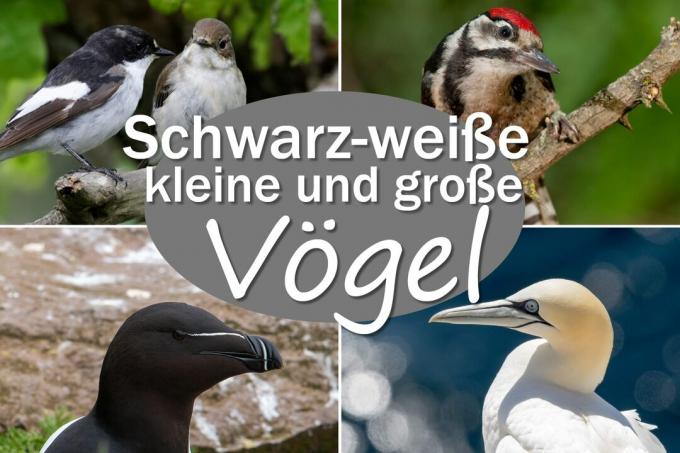
table of contents
- Unobtrusively black and white
- Small black and white birds
- Medium sized black and white birds
- Big black and white birds
- frequently asked Questions
The bird world is quite diverse. There are many brightly colored birds there that immediately catch the eye. But there are also simply black and white birds.
In a nutshell
- black birds between 12 cm small and 110 cm large
- Smallest species of pied flycatcher
- Lapwing is considered an endangered species
- Oystercatcher does not eat oysters
- White stork as a messenger of good luck
Unobtrusively black and white
Among the bird species there are wonderfully colorful "birds of paradise". They stand out from afar simply because of their coloring. However, not every bird is affected. So there are also just black and white colored animals. But that doesn't make them any less interesting. Some species live on land and others live in water. Below is a small list.
Small black and white birds
pied flycatcher (Ficedula hypoleuca)
The plumage of the small bird is black to brownish in color with a white underside and throat, as well as white secondaries. The base of the beak is decorated with a white spot.

- Size: 12 to 13 cm
- Occurrence: Deciduous and mixed forests, parks, gardens
- Food: Spiders, insects, also berries
- Voice: chirping, "tsi - writsu - writsu" or "wuti - wuti", warning call: short, "pik" or "tett"
- migration behavior: Long-distance migrants, winters in the Sahara, can be observed here from May to August
- Special feature: considered endangered
house martin (Delichon urbicum)
In the light, the black wing surfaces shimmer slightly bluish. The underside and the rump is white. The short, broadly forked black tail is typical.

- Size: 13 to 15 cm
- Occurrence: open terrain, near water bodies, nest building on tall buildings
- Food: mosquitoes, flies, aphids
- Voice. chattering, "schrrip" or "brrit", warning call: "tschierr"
- migration behavior: Long-distance migrant, winters in Africa, observed here April to September
Notice: They build their breeding grounds as closed clay nests on the outer walls of tall buildings. Their nests existin from 1500 collected balls of clay.
wagtail (Motacilla alba)
The wagtail is slender in build with a white to greyish surface, white belly and white facial area. The head and chest are black. The black tail is lined with white outer edges.
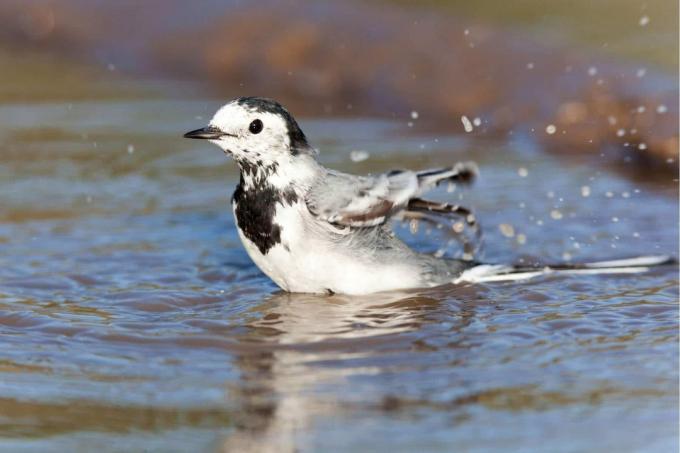
- Size: 16 to 19 cm
- Occurrence: open cultural landscapes, settlement areas, cattle pastures, fields
- Diet: Insects, larvae, spiders, snails, worms, seeds
- Voice: "zilipp" and "tsli-witt"
- Migration: Partial migrants, overwintering in south-western Europe and North Africa, observed here from March to October
- Special feature: Searching for food mainly on the ground, typically tripping and quick steps
barn swallow (Hirundo rustica)
The plumage of the barn swallow appears shiny blue-black. On the other hand, the underside is white and has a black chest band. The brown-red field of vision and the forked tail are typical.
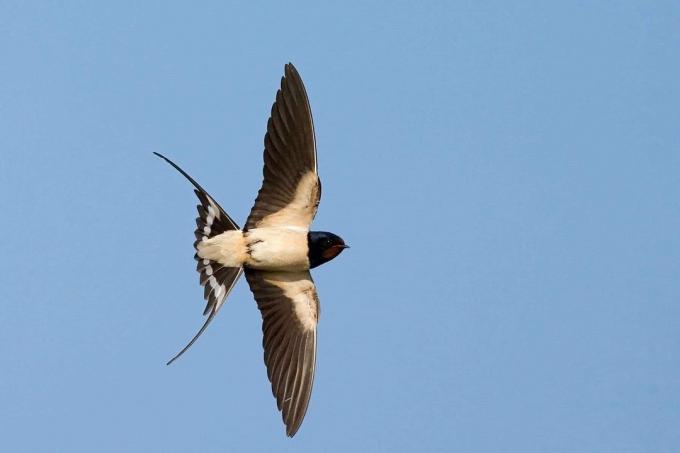
- Size: 17 to 19 cm
- Occurrence: rural areas, stables and barns
- Food: mosquitoes, flies, spiders
- Voice: loud and chirping, "witt - witt"
- Migration: long-distance migrants, overwinters in Africa, can be observed here from April to October
- Special feature: mud nests in stables, passageways, cave entrances, fast flight, 20 meters per second
Notice: This bird can signal a change in the weather. Dif wWhen the barn swallow flies low, rainy weather is approaching.
great spotted woodpecker (Dendrocopos major)
The wings of this bird are black and white and the belly is light to white in colour. The deep red undertail cover and the dark, chisel-shaped beak are characteristic. Male animals can be recognized by the red crest spot.
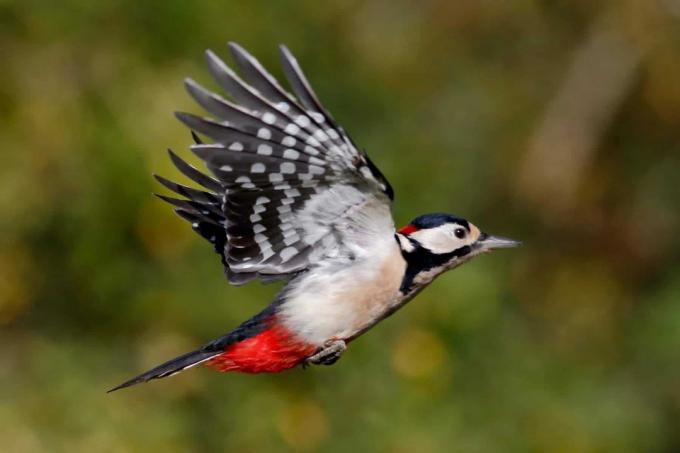
- Size: 23 to 26 cm
- Occurrence: deciduous and coniferous forests, copses, gardens, parks
- food: wood-dwelling insects, their larvae, spruce and pine seeds, eggs, young birds
- Voice: short "kix", frequent typical drumming
- Migration: Resident bird, can be observed all year round
Notice: The great spotted woodpeckers clamp the cones in the so-called woodpecker forges in the bark and chisel them open with their beaks.
Medium sized black and white birds
lapwing (Vanellus vanellus)
The pigeon-sized plover is also colored black and white. In the light, the plumage shimmers slightly violet to metallic green. Typical of this bird are the quills on the head and the rounded wings. The wingspan is 67 to 72 cm.
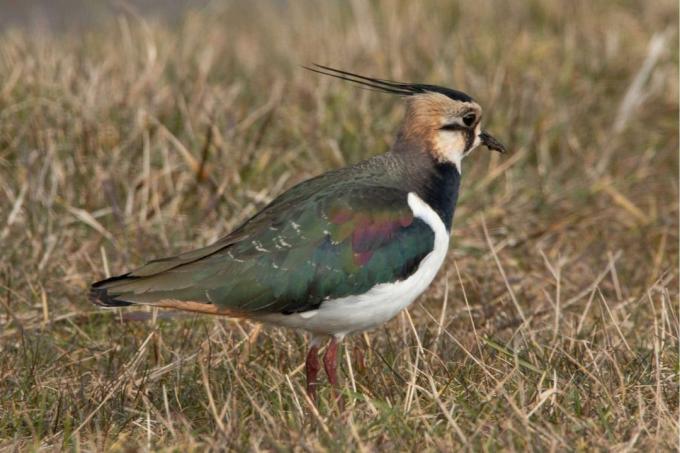
- Size: 28 to 31 cm
- Occurrence: Fields, meadows, moors and wet meadows
- Food: Insects, their larvae, earthworms, seeds, cereal grains, fruits of meadow plants
- Voice: "kie - wit", "chä - chuit" and "wit - wit - wit - wit"
- Migration: Partial and short-distance migrants, hibernating in France, Spain, Great Britain, some remaining in Germany in mild winters
- Special feature: acrobatic flight maneuvers at breeding sites, large loops followed by a nosedive
Notice: The lapwing is Bird of the Year 1996. Dby one intensive farming, the bird is highly endangered.
Razorbill (Alca torda)
This seabird has black upperparts and white lowerparts. The dark high beak, flattened at the sides, is marked with white lines. A narrow white longitudinal stripe also runs from the beak to the eyes.

- Size: 38 to 43 cm
- Occurrence: Seabird, brood in caves or on ledges
- Diet: Molluscs and crustaceans, small marine fish
- Voice: mostly silent, growling "urrr" at the hatchery
- Migration: sedentary or short-distance migrants, wintering North Sea, observed only during breeding
- Special feature: In this country only breeds on Heligoland.
smew (Mergellus albellus)
The plumage of the small, compact bird is white with contrasting black areas. The dark beak has small horn teeth.
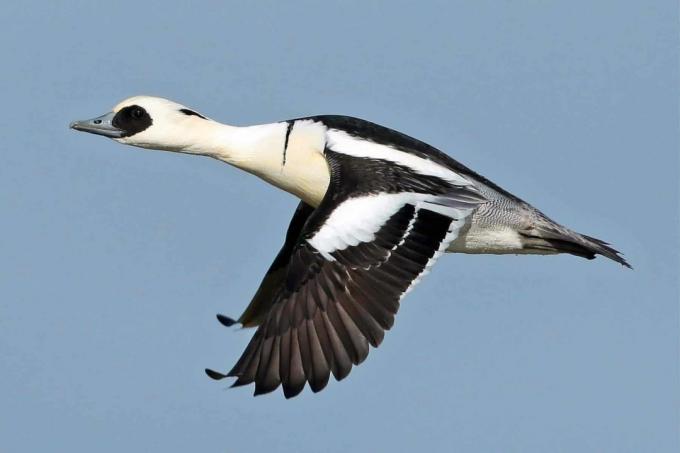
- Size 38 to 44 cm
- Occurrence: in the north, clear lakes, running water
- Food: small fish, reptiles, amphibians, small crustaceans, insects, their larvae
- Voice: mainly mute, only croaking "gurr`r`rr - bye" during the breeding season
- Migration: Short-distance migrants, winters in Central Europe, regular winter guests in Germany too
- Specialty: Cave Breeders
guillemot (Uria aalge)
This small penguin-like seabird has a black to tan plumage finish. The head is colored as well. On the other hand, the underside is white. The narrow and pointed beak is typical.
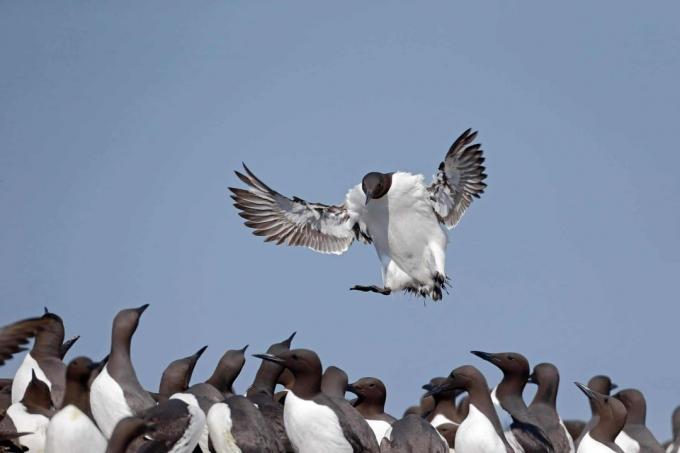
- Size: 38 to 46 cm
- Occurrence: on the seas, only on land during the breeding season, breeding sites in colonies on steep cliffs such as Lummenfelsen in Heligoland
- Food: smaller schooling fish, molluscs and crustaceans
- Voice: "ha - aaahr" at the hatchery
- Migration behavior: resident birds sometimes short-distance migrants
Notice: Parents of the black and white bird can identify their eggs by the shell. This has characteristic spots.
oystercatcher (Haematopus ostralegus)
The head, neck, mantle and forechest and wing tops are black. The rest of the body is white. In contrast, the eyes, dark circles, legs and beak have a striking coral red colouration.

- Size: 39 to 44 cm
- Occurrence: open areas on coasts, wet meadows, also inland
- Food: annelids, mussels and crustaceans, larvae
- Voice: very happy to sing, "kiewiep"
- Migratory behaviour: Resident bird with wintering in the Wadden Sea, sometimes long-distance migrants with wintering on the coasts of Africa and Western Europe, mostly observed all year round
- Special feature: flattened, pointed beaks for opening shells and shells of beach crabs
magpie (Pica pica)
The great raven has a white belly, flanks, shoulders and hand wings. The rest of the body is black. In the light, the plumage shines slightly greenish to metallic blue.
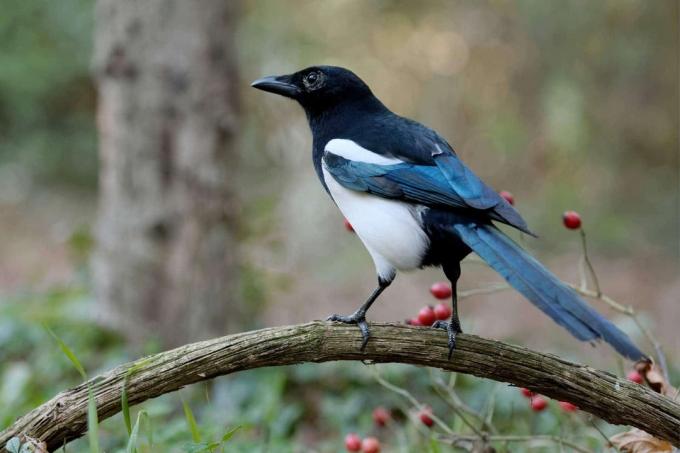
- Size: 40 to 51 cm, including the tail 20 to 30 cm
- Occurrence: open landscapes, residential areas, parks, gardens
- Diet: Smaller vertebrates, earthworms, bird eggs, seeds, berries and fruits, waste
- Voice: rather bleating, "tscha - k" or "Tschaak - tscha"
- Migration: Resident bird, can be observed all year round
- Characteristics: very intelligent, briefly hiding food in holes in the ground, building nests in trees with a roof made of branches
Notice: This black and white bird is often said to be a thief and prefers to steal shiny objects. Ahowever could dhey have not been proven so far. You're just curious.
Big black and white birds
loons (Gavia always)
The bird has black plumage with a white dotted neck ring. A white cube pattern can be seen on its back. The wingspan of the loon is 122 to 148 cm.

- Height: 73 to 88 cm
- Occurrence: mainly in North America, Iceland, on inland lakes in taiga and tundra, Atlantic, along the North Sea coast, also occasionally visible on Lake Starnberg
- Food: frogs, crabs, fish, snails, insects, seeds
- Voice: extremely callous, "ho - wuwuwuwuwu" and howling sounds like "wuwu - wuwwu - awwwu - a
- Migration: Short and medium-distance migrants, hibernating in the North Sea and the Atlantic, observed here from November to March
gannets (Morus bassanus)
The head is yellow in color with a grey-blue beak. The rest of the plumage is white with black wingtips. The large black webbed feet and light blue eyes are striking. The wingspan is 170 to 192 cm.
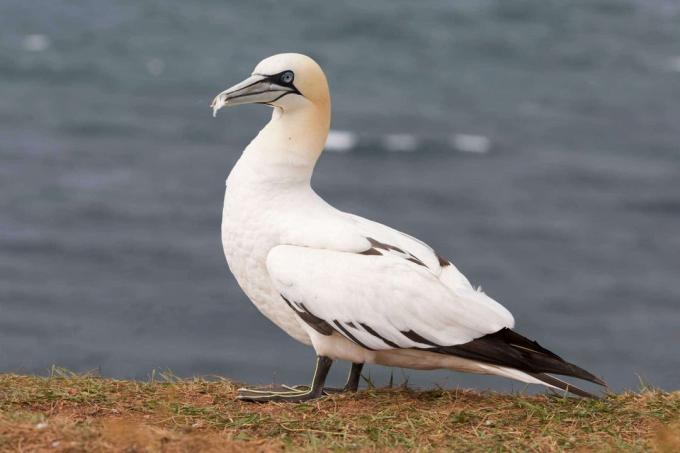
- Size: 85 to 97 cm
- Occurrence: Rocky islands, steep coasts, cliffs, outside the breeding season on the open sea
- Food: Fish and fish waste
- Voice: croaking "rab - rab - rab" or "arrah - arrah" before the flight "u - ah"
- Migration: Short-distance and medium-distance migrants, overwinters in the Atlantic to West Africa, sometimes in the North Sea, can be observed here from April to June
- Special feature: excellent fliers, fishing in shock diving, with speeds of up to 100 kilometers per hour
white stork (Ciconia ciconia)
The plumage is predominantly white, only the flight feathers and parts of the wing surfaces are black. Typical of the white stork is its long red beak and red legs.
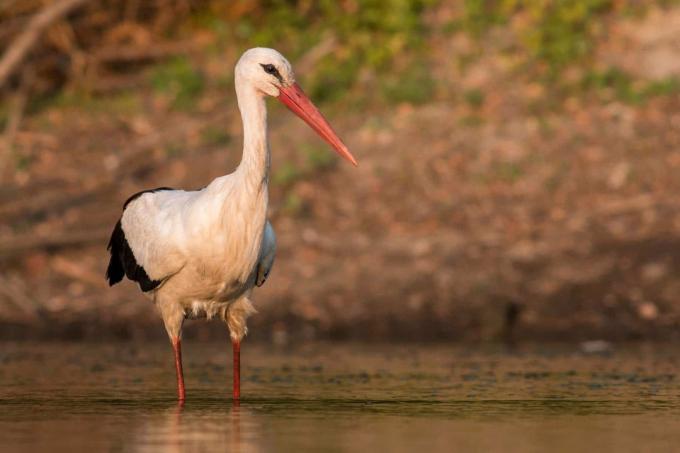
- Size: 95 to 110 cm
- Occurrence: open cultivated landscapes, along watercourses, wet meadows, meadows and pastures
- Food: amphibians, reptiles, mice, earthworms, insects
- Voice: mostly mute, mainly wooden clacking of the beak typical at the nest
- Migration: Long-distance migrants, wintering in Africa
- Special features: Nest building with twigs on chimneys, masts, roofs, church towers, quiet gliding with necks stretched forward
Notice: This black and white bird was also nicknamed the “rattle stork” because of the rattling noises it made with its beak. He is considered a messenger of good luck and brings the babies.
frequently asked Questions
Yes, this is how birds can be distinguished. Pay attention to the color of the head, belly and back. Existing tapes, patterns or drawings can also provide clues. The color of the eyes and the beak are also important.
Yes, that is also possible. A bird's song is distinctive. However, it varies from species to species.
This includes migratory birds. In the case of a long-distance migrant, the breeding areas are more than 4,000 kilometers away from their winter quarters. In the case of short-distance migrants, the distance between breeding and wintering areas is around 2,000 kilometers. Resident birds, on the other hand, remain in their breeding areas all year round.
